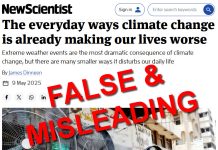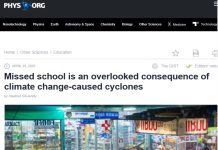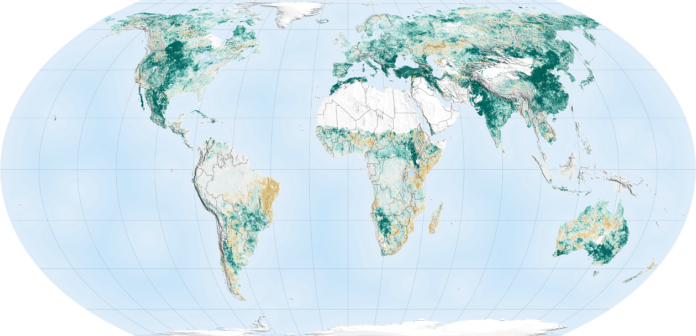Image: Green areas saw a growth in foliage from 2000 to 2017, while brown areas saw a drop. JOSHUA STEVENS / NASA EARTH OBSERVATORY
A July 16th article published by Yale Environment 360 claims global greening is not a positive, but rather a negative because it will harm water supplies. This claim is at best amusing, and at worst, misleading. While acknowledging that many scientists see the greening of the Earth due to rising CO2, especially its desert regions, to be beneficial, the writer tries spin that as a negative.
The Yale Environment 360 article titled “With CO2 Levels Rising, World’s Drylands Are Turning Green,” is amusing because its author, Fred Pearce, couldn’t help putting a negative spin on some very positive news.
The subtitle of the article reads:
Despite warnings that climate change would create widespread desertification, many drylands are getting greener because of increased CO2 in the air — a trend that recent studies indicate will continue. But scientists warn this added vegetation may soak up scarce water supplies.
First, we should applaud Yale Environment 360 for bringing out the good news about the effect of carbon dioxide (CO2) towards greening the planet. The article adds:
What is going on? The primary reason, most recent studies conclude, is the 50-percent rise in carbon dioxide concentrations in the atmosphere since preindustrial times. This increased C02 is not just driving climate change, but also fast-tracking photosynthesis in plants. By allowing them to use scarce water more efficiently, the CO2-rich air fertilizes vegetation growth in even some of the driest places.
This greening due to increased CO2 is something we have reported before here on Climate Realism. Data from satellite measurements indicates that the globe has increased its green area about 5% over the first 20 years of the 21st century. The Sahara Desert is becoming smaller as a result. A 2018 study by Venter et al found the Sahara desert had shrunk in area by 8 percent over the previous three decades.
At issue is the claim made by Pearce, “But scientists warn this added vegetation may soak up scarce water supplies.”
This is simply untrue. For example, in Africa, trees make desert land fertile again:
For once there is some good news from Africa. Farmers are reclaiming the desert, turning the barren wastelands of the Sahel region on the Sahara’s southern edge into green, productive farmland.
Satellite images taken this year and 20 years ago show that the desert is in retreat thanks to a resurgence of trees. They are mainly ana trees (Faidherbia albida), a type of acacia. Wherever the trees grow, farming can resume.
Tree planting has led to the re-greening of as much as 3 million hectares of land in Niger, enabling some 250,000 hectares to be farmed again.
The key factor is evapotranspiration. Evapotranspiration, which is the combination of evaporation and plant transpiration (water into the air from leaves), is a key factor in the formation of deserts. Deserts form when the amount of water that evaporates from the ground is greater than the amount of rain or snow that falls. This is because deserts are arid, or dry, and receive no more than 10 inches of precipitation per year.
Evapotranspiration is an energy-driven process that increases with temperature, solar radiation, and wind. In deserts, the rapid heating and cooling of the air creates strong winds that circulate hot, dry air, which further increases evaporation rates. For example, in American deserts, evaporation can range from 70 to 160 inches per year. With that rate of water loss, deserts remain deserts – they are locked in by the evaporation process.
But with trees, the cycle is broken. Tree leaves both reflect and absorb sunlight so that solar radiation to the ground is reduced and thus ground temperatures are reduced. With lower ground temperatures, the tree canopy sunshield actually reduces evaporation, and therefore helps the desert retain more ground water.
Modest warming has already produced slightly higher rainfall totals. Also, as Agronomy and Botany explain under higher CO2 conditions plants use water more efficiently, losing less moisture to transpiration. So, plants use water more efficiently and the increase in plants reduces moisture loss in arid regions. How terrible!
This is basic plant science, known for decades that reduces any claimed increase in water use, but Pearce missed it entirely. Or perhaps, he knows of it and preferred to keep the narrative of “CO2 driven climate change is the cause of everything bad happening on Earth” alive and well, facts be damned.
Given the many examples we illustrate weekly here at Climate Realism of the media sticking to that narrative in the face of contrary facts, it isn’t at all surprising that Yale Environment 360 attempted to spin good news about global greening into bad. Shameful, but not surprising. For climate alarmists, it seems, maintaining narrative is more important than reporting the facts.





















Another dismal example of negating any positive development on the climate front as detrimental is entirely laughable. Denying the benefits is unscientific and purely political shows the such a radical view of this progressive agenda! They have lost all credibility and seriously undermine their ability to convince anyone of their radical extremism! There is no confidence they will ever change in reporting factual information but to twist themselves into pretzels 🥨 in order to make everything seem worse.